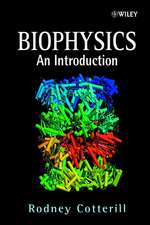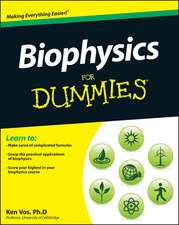Nonlinear Analysis of Physiological Data
Editat de Holger Kantz, J. Kurths, Gottfried Mayer-Kressen Limba Engleză Paperback – 20 dec 2011
Preț: 643.34 lei
Preț vechi: 756.86 lei
-15% Nou
Puncte Express: 965
Preț estimativ în valută:
123.10€ • 128.79$ • 102.26£
123.10€ • 128.79$ • 102.26£
Carte tipărită la comandă
Livrare economică 02-16 aprilie
Preluare comenzi: 021 569.72.76
Specificații
ISBN-13: 9783642719516
ISBN-10: 3642719511
Pagini: 356
Ilustrații: VIII, 344 p.
Dimensiuni: 155 x 235 x 19 mm
Greutate: 0.5 kg
Ediția:Softcover reprint of the original 1st ed. 1998
Editura: Springer Berlin, Heidelberg
Colecția Springer
Locul publicării:Berlin, Heidelberg, Germany
ISBN-10: 3642719511
Pagini: 356
Ilustrații: VIII, 344 p.
Dimensiuni: 155 x 235 x 19 mm
Greutate: 0.5 kg
Ediția:Softcover reprint of the original 1st ed. 1998
Editura: Springer Berlin, Heidelberg
Colecția Springer
Locul publicării:Berlin, Heidelberg, Germany
Public țintă
ResearchDescriere
This book is more than a standard proceedings volume, although it is an almost direct result of the workshop on "Nonlinear Analysis of Physiologi cal Time Series" held in Freital near Dresden, Germany, in October 1995. The idea of the meeting was, as for previous meetings devoted to related topics, such as the conference on dynamical diseases held near Montreal in February 1994 (see CHAOS Vol. 5(1), 1995), to bring together experts on the techniques of nonlinear analysis and the theory of chaos and applicants from the most fascinating field where such methods could potentially be useful: the life sciences. The former group consisted mainly of physicists and mathe maticians, the latter was represented by physiologists and medical researchers and practitioners. Many aspects of this workshop were unusual and not previously expe rienced. Also, the hosting institution, the Max Planck Institute for Physics of Complex Systems (MPIPKS), at this time was brand new. The organiz ers' rather unconventional intention was to bring specialists of both groups together to really work together. Therefore, there was an excessive availabil ity of computers and the possibility to numerically study time series data sets practitioners had supplied from their own fields, e. g. electrocardiogram (ECG) data, electroencephalogram (EEG) data, data from the respiratory system, from human voice, human posture control, and several others. These data formed a much stronger link between theoreticians and applicants than any of the common ideas.
Cuprins
I Directions in Nonlinear Data Analysis.- Processing of Physiological Data.- Problems in the Reconstruction of High-dimensional Deterministic Dynamics from Time Series.- Chaotic Measures and Real-World Systems: Does the Lyapunov Exponent Always Measure Chaos.- Ranking and Entropy Estimation in Nonlinear Time Series Analysis.- Analysing Synchronization Phenomena from Bivariate Data by Means of the Hilbert Transform.- Analyzing Spatio-Temporal Patterns of Complex Systems.- II Cardio-Respiratory System.- Are R-R-Interval Data Appropriate to Study the Dynamics of the Heart.- New Nonlinear Algorithms for Analysis of Heart Rate Variability: Low-Dimensional Chaos Predicts Lethal Arrhythmias.- Nonlinear Analysis of the Cardiorespiratory Coordination in a Newborn Piglet.- Cardiorespiratory Synchronization.- III EEG Analysis.- EEG Signal Analysis by Continuous Wavelet Transform Techniques.- Relativity of Dynamical Measures in Study of the Human Brain: Local Lyapunov Exponent as a Tool for Comparative Studies.- Classification of EEG Signals Prom a Music Perception Experiment Using Empirical Dynamical Models.- IV Perception and Motor Control.- Nonlinear Analysis of Perceptual-Motor Coupling in the Developement of Postural Control.- Symbolic Dynamics of Bimanual Production of Polyrhythms.- Human Postural Control: Force Plate Experiments and Modelling.- Delay Induced Patterns of Visually Guided Movements.- V Voice.- Detecting Bifurcations in Voice Signals.
Textul de pe ultima copertă
This book surveys recent developments in the analysis of physiological time series. The authors, physicists and mathematicans, physiologists and medical researchers, have succeeded in presenting a review of the new field of nonlinear data analysis as needed for more refined computer-aided diagnostics. Together with the techniques, they actually propose a new approach to the problems. Practitioners may find the many applications to the cardio-respiratory system, EEG analysis, motor control and voice signals very useful.
Caracteristici
Nonlinear methods to analyze predical data and their implementation in computer-aided diagnostics are very new but of growing importance despite their inherent complexity.











